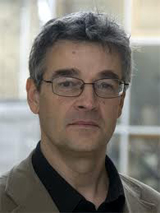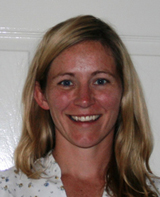
In its inaugural list of the top 50 most influential people for sustainability in the UK, Building Design magazine has listed three Cambridge academics. The range of work they do gives us an overview of just how broad the meaning of sustainability is.
At the moment, a truly vast amount of the world’s energy consumption - around 38% of its total - is accounted for in buildings.
Professor Koen Steemers
The UK government’s Climate Change Act of 2008 committed this nation to an ambitious but essential aim – an 80% reduction of greenhouse gas emissions by 2050. That this goal has been set is an important step, showing the UK’s commitment to edging humanity back from the ecological brink, but the absolutely critical step will be meeting it.

The demand and consumption of energy that leads to the annual pumping of millions of tonnes of carbon and other damaging gases into the atmosphere is beginning to render our existence as a species quite literally unsustainable.

‘Sustainability’ is often used as common parlance for vague notions of eco-friendly activity – but in truth it is far more fundamental. Internet godhead Wikipedia describes sustainability as “the capacity to endure” – essentially, ensuring our future. Sustainability is the best humanity can hope for – and it’s going to be an uphill struggle all the way.

Central to the human fight for the “capacity to endure” will be the people who design and build the stuff that facilitates our lives – and consequently requires the energy – the infrastructure, buildings and materials that millions rely on in the 21st century.
In March of this year, to coincide with the Ecobuild 2012 – the world’s biggest sustainable construction design conference – the architecture newspaper Building Design drew up a list of the UK’s 50 most influential figures in sustainability: three of whom are Cambridge academics – Peter Guthrie, Koen Steemers and Julian Allwood.
Peter Guthrie is the first Professor in Engineering for Sustainable Development in the UK, a post he has held since 2000. With a background in civil engineering, Guthrie has worked on road networks and major infrastructure projects in developing countries, and around the world, for decades. In 1980, after working in a refugee camp during the Vietnamese Boat People crisis, he founded RedR, a charity that provides engineers to relief agencies in disasters.
At Cambridge, Guthrie is Director of the Centre for Sustainable Development, where he directs research on the Energy Policy and Efficiency in the Built Environment programme among others. He has advised on environmental policy for many countries and worked on many major projects including London 2012, Channel Tunnel Rail Link, and Birmingham, Liverpool and Manchester Airports.
“In the Centre, our research seeks to grapple with the many facets and multi-disciplinary nature of sustainable development, embracing and addressing social, economic and environmental aspects together and in their complex interaction,” says Guthrie. “Achieving moves towards the change in the way development is delivered requires new approaches and we are seeking to define these and work with new approaches.”
Koen Steemers is Professor of Sustainable Design and Head of the Department of Architecture at Cambridge. One of his focusses is energy demand in cities, looking at design software that informs urban building for effective use of lighting, heating and ventilation. Buildings account for 50% of the carbon emissions in the UK, but human perception is rarely considered as a major factor.
“At the moment, a truly vast amount of the world’s energy consumption – around 38% of its total – is accounted for in buildings, often as a result of the attempt to provide an artificially uniform environment,” says Steemers.
“We need to enhance the technical potential of design, environmental systems and controls supporting energy efficient behaviour. Refurbishing existing buildings is a priority – 80% will still be here in 2030.” Steemers is the author of 10 books including Sustainable Urban and Architectural Design (2006) and Environmental Diversity in Architecture (2004).
“The design of sustainable buildings and cities is about much more than reducing the demand of non-renewable resources – it is about providing beautiful environments to live, play and work in. It is critical to ensure that the quality of the built environment is improved hand-in-hand with improved technical performance to deliver ‘win-win’ solutions.”
Julian Allwood is a leader in the sustainable materials field, and heads up the Low Carbon and Materials Processing group in the University’s Department of Engineering. The group are dedicated to seeking out and developing opportunities for engineering to contribute to a low carbon future, particularly reducing energy demand in big industry – an area vital to the government’s targets.
Along with his team of researchers, Allwood has produced the first study on transforming an industrial sector, textiles, to have sustainability as its goal – and how to move to localised production, identifying practical steps at business unit level to reduce carbon emissions.
A recent development has been the research into ‘un-printing’, using lasers to remove ink from scrap paper – allowing the paper to be reused, without being discarded, shredded or sent to a recycling plant.
“This could represent a significant contribution towards the cause of reducing climate change emissions from paper manufacturing,” says Allwood. “Thanks to low-energy laser scanners and laser-jet printers, the feasibility for reusing paper in the office is there.”
If we are to make the 80% reduction in greenhouse gas emissions by 2050, sustainability in construction and engineering will be fundamental – for the UK and the state of our planet. These three academics represent a small part of Cambridge’s collective efforts in the fight for all our futures.
In another list but this time of the 'Top 50 rising stars of sustainability' two students and one graduate from the Interdisciplinary Design for the Built Environment (IDBE) masters course, run jointly by the Departments of Engineering and Architecture, have been named. Building magazine scoured the construction industry to find the next generation of sustainable leaders - people who have grown up in a world where environmental issues have always been a talking point and who refuse to accept this part of their roles as merely an 'add-on'. Among them are two students currently on the IDBE course, Holly Knight and Alasdair Young, as well as a graduate of the course Clive Fussell.
As well as being named in the 'Top 50 rising stars of sustainability', Holly Knight has also been listed in Building Design Magazine's 'Top 50 Green Leaders', dubbed as the '50 most influential people in UK sustainability'

Holly Knight, 33, is Principal Sustainability Manager with the Olympic Delivery Authority. A specialist in water, she regards her most significant sustainability achievement as working on the Old Ford waste water recycling plant on the Olympic park. Holly joined the IDBE course in 2010 and led a guided tour of the Olympic park in June 2011 for her student cohort.

Alasdair Young, 32, Associate, Buro Happold, completed his MEng in mechanical engineering at Cambridge in 2003 gaining first class honours, and joined the IDBE course in 2009. As a senior engineer in Buro Happold's Sustainability and Alternative Technology group, he has worked on numerous projects involving sustainable energy, water and waste systems. In addition to being the group's champion for combined heat and power, he has also worked on low carbon technologies such as biomass and large scale wind power systems. He co-authored the influential report 'Powering ahead: delivering low carbon energy for London'.

Clive Fussell, 39, joined the IDBE course in 1999 and graduated in 2002. A structural engineer formerly with Buro Happold, he is a founding partner with another IDBE graduate Paul Grimes, of the engineering consultancy Engenuiti. Among a wide-ranging engineering portfolio, the practice has been appointed engineering consultant for a number of low carbon schools constructed using cross laminated timber panels.
Building Design's 'Top 50 Green Leaders' list can be downloaded as a PDF: BD's Top 50 Green Leaders 2012.pdf
Building magazine's 'Top 50 rising stars of sustainability' can be found at: www.building.co.uk/technical/sustainability/top-50-rising-stars-of-sustainability/5032914.article

